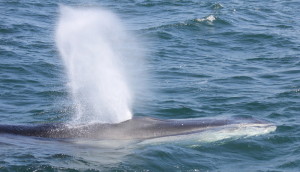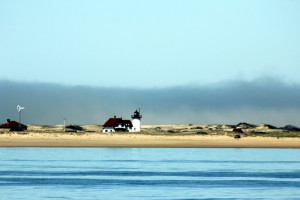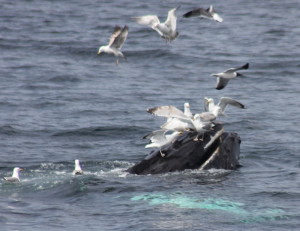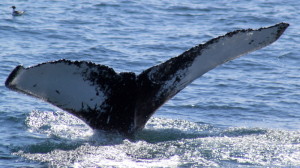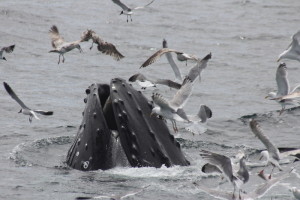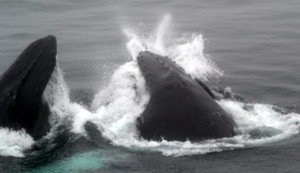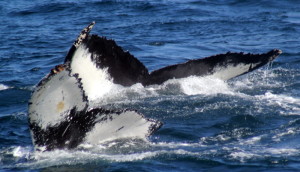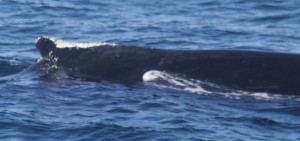Naturalist Notebook – May 4 to May 10
A bright cold spring day was perfect for watching the second-largest animal in the world in the form of the massive fin whales seen off Cape Cod on May 4. The huge whales, including an individual known as Loon, appeared to be feeding just beneath the surface.
Plankton tows indicated dense concentrations of copepods, however no planktivorous right or sei whales were spotted. Several harbor seals were also seen. May 5 brought similar conditions, but a slightly greater diversity of species, including minke and humpback whales, harbor porpoise, harbor seals, and phenomenal views of fin whales.
Dense fog to the northeast meant that the best sighting conditions on May 6 were near shore, where a pair of fin whales and a minke whale were spotted.
The fin whale known as Loon delighted passengers and crew alike, gliding past the Dolphin IX in calm water that allowed great views of the massive animal beneath the surface.
On May 7, the fog had lifted and the Dolphin IX steamed up to the southern edge of Stellwagen Bank, where at least a dozen feeding humpback whales were spotted.
While the feeding humpbacks stole the show, an unusual scene unfolded overhead as a number of herring gulls appeared to be harassing a small hawk or other raptor.
It was a great day for birders as well as whale watchers, as common loons, sooty shearwaters, and common and roseate terns were also among the species spotted. Many familiar humpback flukes were spotted – for a full list of individuals identified, see our sightings blog.
On May 8, amid rain showers, eager whale-watchers were treated to another feeding frenzy on the southwest corner of Stellwagen Bank as nearly 15 humpbacks used clouds of bubbles to drive their prey to the surface before engulfing it with their massive jaws.
Another great day transpired for birders, as glaucous and Bonaparte’s gulls were among those around the feeding humpbacks. Other birds seen included parasitic jaegers, common terns, common loons, and razorbills. On May 9, morning sighting conditions were not ideal, but thick fog did not dampen the enthusiasm of the Dolphin IX crew as they steamed up to Stellwagen Bank. As the fog lifted, nearly 30 feeding humpbacks were spotted, and a wide array of feeding behaviors were observed, from bubble clouds and nets to kick feeding and surface lunges.
The morning of May 10 began with a sighting of the humpback whale known as Northstar, an animal of unknown sex and age first seen in 2008, waving its massive flippers just off Race Point, as if beckoning the whale watchers to come offshore.
However, the highlight of the day would again be the large number of feeding humpbacks spotted on Stellwagen Bank as the morning fog lifted. A humpback mother and calf were spotted, along with nearly 50 Atlantic white-sided dolphins. In the afternoon, everyone aboard the Dolphin IX was thrilled to see Salt, arguably the most well-known wild whale in the world, easily recognized by even the most novice naturalists by her distinctive dorsal fin and fluke patterns.
The first North Atlantic humpback to be named and cataloged, she has been seen in the Gulf of Maine consistently since 1975, and has given birth to at least 12 calves.






